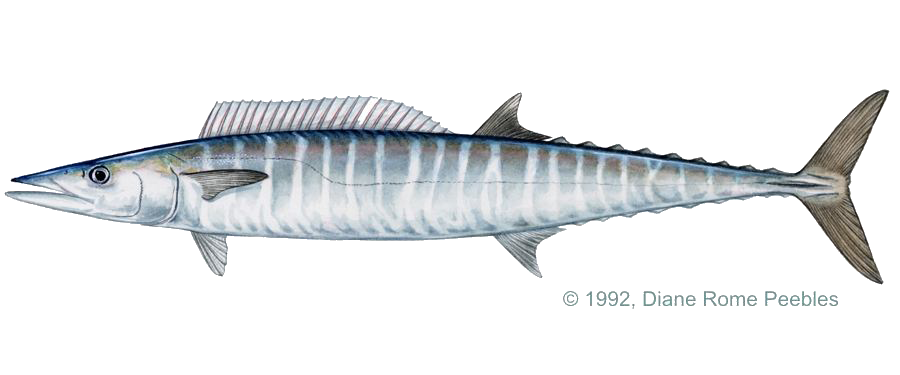Game Fish Identification Reference Guides
Wahoo
(Acanthocybium solandri)
(Acanthocybium solandri)

(Cuvier, 1832); SCOMBRIDAE FAMILY; also called oahu fish, Pacific kingfish
Worldwide in tropical and warm temperate seas. Pelagic and seasonally migratory, it tends to be a loner or travel in small groups of 2 to 6 fish. There are indications of seasonal concentrations off the Pacific coasts of Panama, Costa Rica and Baja California in the summer, off Grand Cayman (Atlantic) in the winter and spring, and off the western Bahamas and Bermuda in the spring and fall.
The upper jaw is movable and the teeth are large, strong and laterally compressed. The well defined lateral line dips noticeably near the middle of the first dorsal fin, further forward than on the similar looking tanguigue (Scomberomorus commerson), and is wavy back to the tail. The back is a brilliant, deep, blue sometimes described as metallic or electric blue. Bright blue vertical bands, or “tiger stripes”, flow down the sides onto the silver and sometimes join into pairs on the belly. These beautiful stripes are not, however, always prominent in large specimens and occasionally may be missing entirely.
It is found around wrecks and reefs where smaller fish that it feeds upon are abundant, but it may also be found far out at sea.
It is reputed to be one of the fastest fish in the sea, attaining speeds of 50 mph (80 km) and more. The first scorching run may peel off several hundred yards of line in seconds. Occasionally this fish jumps on the strike and often shakes its head violently when hooked in an effort to free itself. Fishing methods include trolling with whole, rigged baits as well as with strip baits or artificial lures. Live bait fishing and kite fishing are productive, but the wahoo is a relatively scarce species and is usually taken incidentally while fishing for other oceanic species. The wahoo has commercial importance in some countries. The flesh is finely grained and sweet and is considered excellent eating
Worldwide in tropical and warm temperate seas. Pelagic and seasonally migratory, it tends to be a loner or travel in small groups of 2 to 6 fish. There are indications of seasonal concentrations off the Pacific coasts of Panama, Costa Rica and Baja California in the summer, off Grand Cayman (Atlantic) in the winter and spring, and off the western Bahamas and Bermuda in the spring and fall.
The upper jaw is movable and the teeth are large, strong and laterally compressed. The well defined lateral line dips noticeably near the middle of the first dorsal fin, further forward than on the similar looking tanguigue (Scomberomorus commerson), and is wavy back to the tail. The back is a brilliant, deep, blue sometimes described as metallic or electric blue. Bright blue vertical bands, or “tiger stripes”, flow down the sides onto the silver and sometimes join into pairs on the belly. These beautiful stripes are not, however, always prominent in large specimens and occasionally may be missing entirely.
It is found around wrecks and reefs where smaller fish that it feeds upon are abundant, but it may also be found far out at sea.
It is reputed to be one of the fastest fish in the sea, attaining speeds of 50 mph (80 km) and more. The first scorching run may peel off several hundred yards of line in seconds. Occasionally this fish jumps on the strike and often shakes its head violently when hooked in an effort to free itself. Fishing methods include trolling with whole, rigged baits as well as with strip baits or artificial lures. Live bait fishing and kite fishing are productive, but the wahoo is a relatively scarce species and is usually taken incidentally while fishing for other oceanic species. The wahoo has commercial importance in some countries. The flesh is finely grained and sweet and is considered excellent eating












